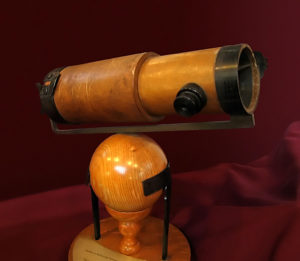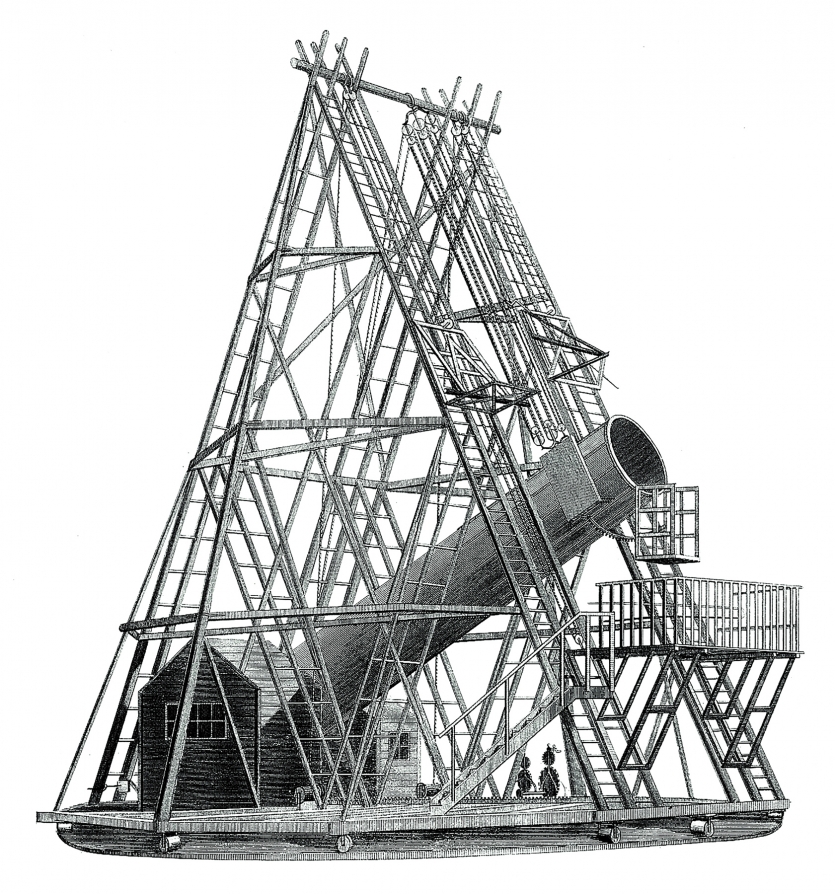The telescope instantly changed the way humanity saw their place in the universe. The backdrop of fixed stars, no longer fixed. The planets, no longer perfect spheres. Hundreds of stars became thousands of stars, then they became hundreds of thousands of stars. Today they number in the hundreds of trillions. The first telescopes to be invented were a type of refracting telescope, which uses lens to collect and focus the image. The trouble with refracting telescopes was that the image was blurry along the edges. This problem was resolved with the design of a new telescope called a reflecting telescope. A reflecting telescope uses a combination of mirrors to reflect and focus the image. Isaac Newton is credited with inventing the first practical reflecting telescope.
Newton’s Reflecting Telescope

After spending time studying optics and the nature of light Isaac Newton became convinced that the image blurriness, called chromatic aberration, could not be eliminated in a refracting telescope design. Chromatic aberration happens because the lens acts as a prism, splitting the light into its various wavelengths. Each of these wavelengths is bent at a slightly different angle resulting in a failure to focus all the different wavelengths (different colors) at a single point, creating the blurred image. Newton did extensive experiments with lights and a prism, so he decided to create an entirely new design for his telescope rather than attempt to improve the design of the refactors.
In 1668 Newton created his first reflecting telescope. This telescope consisted of a large concave primary mirror that focused light on a smaller, flat diagonal mirror which reflected the light into an eyepiece on the side of the telescope. Since no light is being passed through a lens (all of the light is reflected) there is no chromatic aberration. He presented his telescope to the Royal Society of London in 1672.
Although Newton was the first time build a reflecting telescope the idea had been proposed earlier by other people, most notably by James Gregory in 1663 book Optica Promota. Earlier still, Italian astronomer Niccolo Zucchi may also have attempted to construct a reflecting telescope as early as 1616, but his device had difficulties producing a quality image.
Reflecting telescopes have several advantages over the refracting telescope. Significantly, the original refracting telescopes suffered from chromatic aberration noted above which is an optical condition caused by the lens bending light waves onto different focal planes. This results in a magnified yet blurry image. Reflecting telescopes avoid this problem since mirrors always reflect light waves in the same way. This simple fact is obvious to anyone who has looked in the mirror and seen a clear image of themselves. Today, nearly all large astronomical telescopes are reflecting telescopes due to its various advantages in image clarity, cost, and weight over the refracting telescope.
The Reflector after Newton
Despite these advantages it took some time for reflecting telescopes to surpass refracting telescopes as the industry standard. William Hershel was the first person to make significant discoveries using a reflecting telescope. Herschel became interested in astronomy in the 1770s and took to building his own reflecting telescopes to do his research. His early work consisted of searching for binary star systems, during which he made his famous discovery of a new planet in our solar system, Uranus. Uranus, like the classical planets is viable to the naked eye and had been observed before, but was always thought to be a star. In March 1781 Herschel viewed first the planet through his telescope. After subsequent observations using the technique of parallax on fixed stars was able to observe its movement and he initially reported it as a comet. After several more months and with the collaboration of other astronomers it was eventually determined to be a new planet in our solar system.

(Credit: Charles Hutton’s Philosophical and Mathematical Dictionary, 1815)
Herschel continued to make improvements to his telescope design and in 1789 he completed his largest ever, building a huge 40 foot long telescope that contained a mirror 48 inches in diameter. At the time of its completion it was the largest scientific instrument every built. The building of larger and larger telescopes had continued to the present day . As of 2021, the largest reflecting telescopes is the Gran Telescopio Canarias in Spain that has a mirror diameter of over 34.2 feet. On Christmas Day 2021, the James Webb Space Telescope, the most powerful telescope ever put into space, was launched to replace the famous but aging Hubble Space Telescope.
Continue reading more about the exciting history of science!